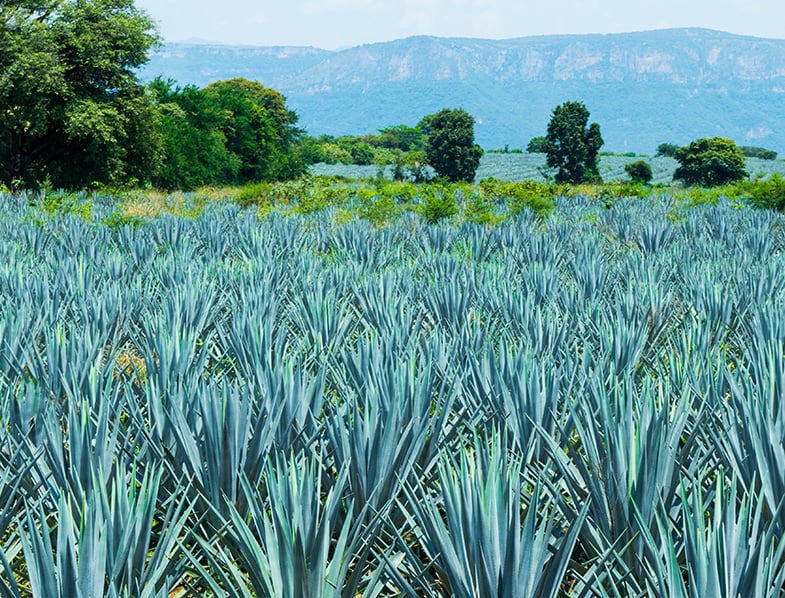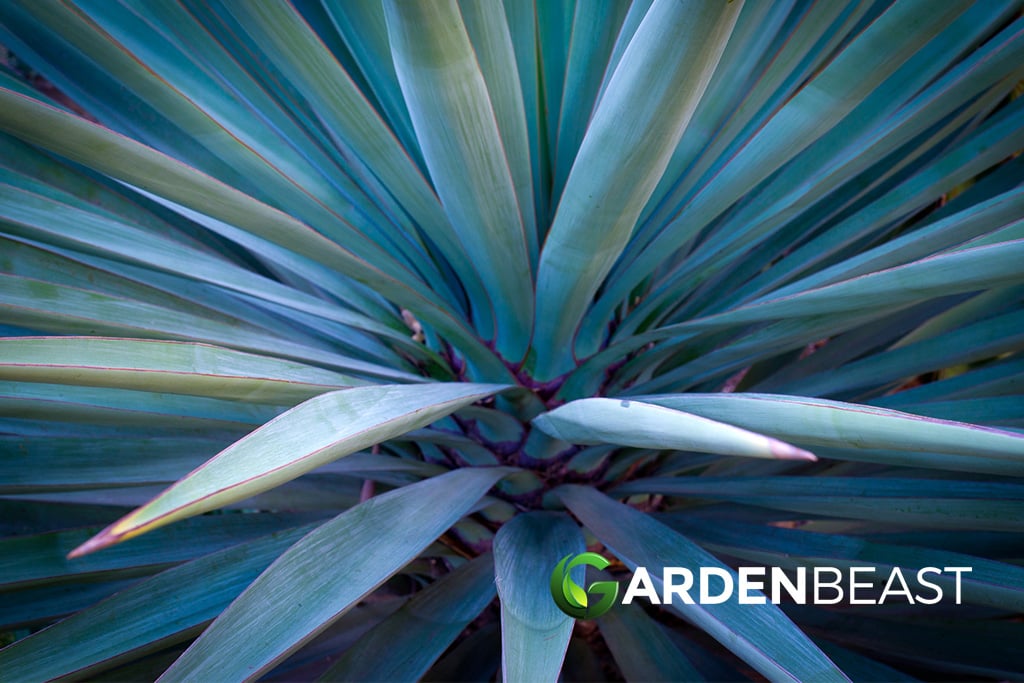Say hello to a gorgeous plant that cannot wait to become part of your plant family! We know you probably think that you already have enough plants around. But you will change your mind as soon as you’ll see how friendly and fun Blue Agave can be!
Agave tequilana, otherwise known as the Tequila Agave or Blue Agave (Agave Azul), is a succulent species of plants in the Asparagaceae family. This agave succulent is native to the Caribbean islands and several regions of Mexico, such as Aguascalientes, Colima, Jalisco, and Nayarit.
Blue Agave plants are highly popular not only for their interesting appearance and easy-going style but also due to their economic importance. Just take a look at their alternative name − Tequila Agave. Once you find out about their secret, it will be very tempting to start your own homemade business. Have you guessed already?
These Latino beauties are the main ingredient of the well-known distilled beverage tequila. However, only a specific cultivar, known as A. tequilana ‘Weber Azul’, is used to make this worldwide-appreciated product. That’s because this Agave plant produces high amounts of sugars, mostly fructose, which makes it a suitable choice for the preparation of alcoholic drinks.
About Blue Agave
- Blue Agave can be found growing only in arid and semiarid regions. It usually grows at high elevations of more than 5000 feet (1500 m).
- Although they are rarely kept as houseplants, a gardener owned a 50-years-old Tequila Agave in Boston. The impressive succulent grew a stalk of 30 feet (9 m). This specimen required a hole in the roof of its greenhouse and bloomed in the summer of 2006.
- Besides tequila, Blue agave plants can also be used to prepare an alcoholic beverage called Agave wine. This is a fortified drink obtained from blending Blanco tequila with fermented Blue Agave.
- Blue Agave plants, along with the Century Plant or Maguey (A. americana), are the primary source of a popular syrup known as agave nectar. This sweetener is often used in drinks and food as a substitute for honey or sugar.
- The nectar produced by the Agave flowers is highly attractive to various species of pollinators, nectar-loving birds such as hummingbirds, and insects including hawkmoths and bees. Their blooms are pollinated by a bat called the greater long-nosed.
- In the past, these succulents and other species of Agave had many popular uses. They were known for their numerous medicinal properties and also used in food recipes, rope/paper production, soap, tattoos, and firewood.
- Thanks to their versatile appearance, Blue Agave plants can be great companions to other species of Agave, ‘Elijah Blue’ fescue (Festuca glauca ‘Elijah Blue’), Blue Chalk Sticks (Senecio mandraliscae), or Coral Aloe (Aloe striata).
- They produce small thorns that can be quite dangerous to children and pets. Keep your Blue Agaves in a location your curious pets and kids don’t have access to.

Blue Agave Features: An Overview
- Blue Agave plants belong to the Agave genus that contains about 200 monocarpic species of succulents and xerophytes. The monocots are grass and grass-like flowering plants that bloom, produce seeds, and die afterward.
- They mature beautifully into large evergreen succulents that can reach at least 7 feet (2 m) in height and diameter. When these plants are about five years old, they sprout an extra stalk.
- Their stalks are commonly known as “quiotes” and can come with an additional height of 16 feet (5 m). The stalks are removed from the commercial plants to send more energy to their ‘hearts’ (the real thick stems).
- Blue Agave plants exhibit a charming rosette of leathery or succulent leaves that can present some spines at their tips and along the margins. Most species can reproduce vegetatively and create clonal rosettes at the base.
- Their leaves come in a wide color range, varying from pale green to bluish-grey. Some specimens can also produce striped or variegated foliage.
- During their blooming period in summer, Blue Agave plants display pretty tall unbranching or branching inflorescences that contain lovely flowers. The inflorescences grow more than 30 feet (9 m) in height.
- The flowers are composed of six petals and produce an abundant amount of nectar. They can come in various shades of yellow, red, or even pale green.
- Their bloomings bear capsule fruits and produce thousands of seeds per plant that can be sterile. After this process, the Blue Agave plants end their life cycle and die.
Growing Blue Agave
In general, arid or semiarid species require lots of sunlight to thrive and Blue Agave plants are no different! When growing these babies outdoors, make sure you choose a nice spot where they can receive at least six hours of bright and direct light daily. Indoors, place your plants in the brightest location in your house, such as near south or west-facing windows. If you cannot provide your Blue Agave plants with the daily amount of sunlight needed, you should add artificial light to their routine.
Blue Agave plants are used to the extreme conditions from their natural habitat. They prefer warmer temperatures that range from 68 to 86 °F (20-30 °C) all-year-round. If you live in a region with harsh winters and freezing temperatures, it is suggested to grow your plants indoors in containers. For outdoor-grown plants, make sure you bring them inside when temperatures start to drop below 50 °F (10 °C), especially during winter, to protect them from frost.
These succulents are usually pest-free, but they can be bothered by agave snout weevils once in a while. These pests damage the larger specimens, feeding on their leaves and stems, and can become a major problem if not kept under control. If your plants are infested recently, you can isolate the infected plants and remove any unhealthy parts. For advanced forms of infestation, however, you must apply broad-spectrum insecticides or imidacloprid granules in spring.

Planting Blue Agave
Whether you grow Blue Agave plants indoors or outdoors, they require a good-quality planting medium that has excellent drainage. These plants will be healthy and happy if they are grown in a commercial potting mix designed for cacti and succulents.
You can also prepare your own substrate by mixing equal parts of coarse sand, perlite, and peat moss. In the cooler months, it is suggested to add mulch around your plants. You can use chopped leaves to replenish nutrients in the soil. This method will provide more nourishment for your Blue Agave plants, especially for established or mature specimens.
When Blue Agaves are planted in suitable potting soil, they don’t usually need much fertilizer. However, some sources recommend feeding your plants with a diluted liquid fertilizer formulated for succulents and cacti once every couple of months. This is not mandatory, so you should fertilize your plants only if you notice a slower growth than normal.
Blue agave plants can be grown in containers without any issues along the way because they grow at a pretty slow pace. While these plants are smaller, they can make for great indoor companions because root crowding is not a problem for them. If they start to outgrow their current pots, make sure you transplant them carefully in new ones that are slightly larger.
Watering Blue Agave
When watering your mesmerizing Blue Agaves, keep in mind that their succulent leaves can store large quantities of water. These plants are quite tolerant of drought, so they will require frequent watering only during their first month after planting. If you provide your fresh-planted succulents with a nice and deep soaking once every week, they will be more than happy. In regions with abundant rainfalls and humidity, you can water your plants less often.
Once they have settled in their new environment, Blue Agave plants will need watering only once or twice a month, and only during their active growing season. However, you must always take rainfalls into account before watering your plants again. If the soil feels damp to the touch, wait for it to dry thoroughly in-between waterings to avoid soggy conditions and over-watering.
During the winter, Blue Agave plants will do well without any extra watering. Keep in mind that it is always better to under-water these succulents than to believe their dramatical signs of thirst. Their leaves are probably all-wet and comfy, so you can allow the soil to stay dry for a month or so.
Propagating Blue Agave
When we look closely at Blue Agaves, we cannot stop but thinking about how much they resemble pineapples! Of course, these succulents are a lot bigger, but they look absolutely stunning and worth to be shared with family and friends. Along with a nice bottle of tequila, a baby Blue Agave can be the perfect gift for a beloved one or a plant-lover acquaintance.

The easiest and most common method to propagate Blue Agaves is through small shoots. The offsets can be removed from the mother plants with a sharp and sterilized knife. Make sure the sprouts have some roots attached and plant the offsets in a suitable potting mix. The root should be dug at about 6 inches (15 cm) deep in the soil, so the cut offsets should be pretty tall.
Water the root cuttings once every few days until they begin to show some roots. Once they have developed a strong and healthy root system, you can provide them with water only once a week. For optimal results, keep your Blue agave offsets in a warm and well-lit location during this process.
In Conclusion
Like most succulents and cacti, these plants are a must-have in every respectable gardener’s collection. Blue Agaves are splendid, low-maintenance, and have a great history. What more could you wish for?
Are you growing Agave plants? Share your experience in the comments below!

1 Comment
Blue agave plants are awesome plants!